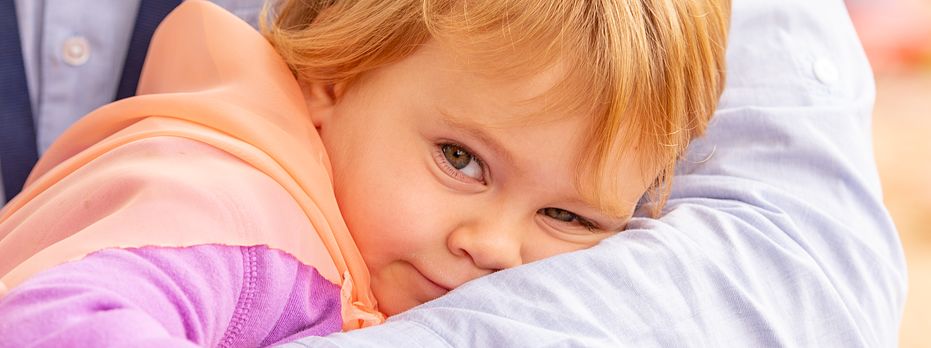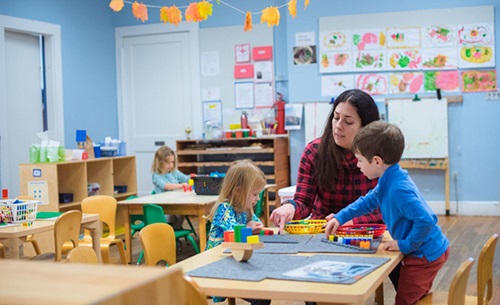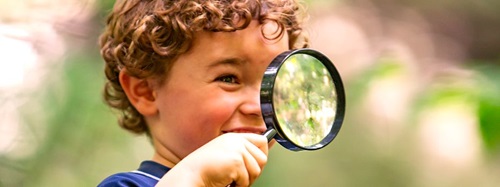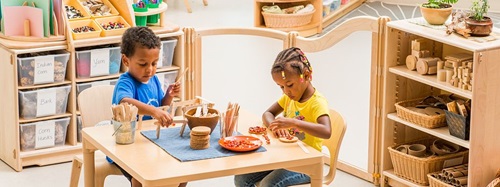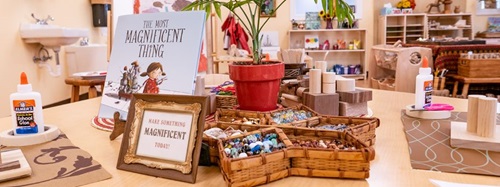What Does it Mean to Care?
| May 2015Child Care vs. Preschool?
A parent approached me a couple years ago and explained in an apologetic tone that she was pulling her daughter out our of our accredited campus child care center to put her in a “real school”. Yes, “real school” is what she said. I mustered up all my professionalism, put aside my pride and proceeded to inquire about her decision. We had a good conversation. She explained that although she loved our program for her toddler and appreciated how happy her daughter was learning through play, she wanted her to have a different experience as a preschooler. She chose a neighborhood preschool where there was an academic curriculum to help her prepare for kindergarten. The parent and I talked about all the names of programs we hear in our field—nursery school, preschool, daycare, and child care—and how confusing they can be. We talked about what it means to be ready for kindergarten and about the pressure kids and parents feel. We talked about the difference between academic skills and intellectual growth. The parent did proceed to enroll her daughter in the nursery school but within a couple months she was back with us; and we were happy to have her back.
I was thankful for this dialog, and I have had many similar talks throughout my career. It was interesting to me that the parent viewed our center as providing great care to her child but she did not initially see us as educational even though all of our teachers have degrees in education. Despite the fact that we articulate our goals, post our curriculum, document each child’s progress in portfolios, provide screening, assessment, and parent teacher conferences this parent did not see us as a “real school”. I know that the way early childhood is viewed in our society is complicated. However, I wondered if part the reason we may not be seen as educational is because we do such a good job caring for children. We help children separate from their parents, hold children on our laps when they need to be held, sit on the floor to teach, and turn our classrooms into home-like environments. These things are seen as something other than, often less than, teaching and learning.
The Inseparability of Early Education and Care
This conversation about the difference between preschool and child-care always leads us to what is at the heart of the issue—the inseparability of early education and care. There is a misperception in our society that child care and early learning are two different things based on the view that child care is custodial and preschool is educational. What we know is that high quality, responsive, intellectually stimulating programs are doing the same thing—simultaneously caring for and educating young children.
Here are some things that can happen when we try to artificially separate early education and care.
- When child care is viewed as custodial work, the caring acts such as helping children gain confidence in toileting, dressing, and meals are devalued. Child care teachers may not be given the respect, support, or professional development to raise standards or to view themselves as teachers. They may feel disenfranchised and adopt the custodial view of their work; they supervise children, keep them safe and clean, but are not empowered to see each moment as an opportunity for learning and teaching.
- When preschools are viewed as an extension of the “big school” it results in push-down pressure. In an effort to show that young children are getting ready for kindergarten, the curriculum may include worksheets or seat work that is better suited for older children. Preschool teachers adopt an elementary school teacher view of themselves and feel most comfortable in roles such as reading stories to groups of children or teaching the alphabet. They may not recognize the powerful connection between caring and teaching. Children may be rushed through daily living activities to get to what is perceived as teaching activities such as circle time. Children are screened for enrollment readiness and may be excluded if they are not fully potty-trained.
In Defense of Early Childhood Education
Early childhood teachers have long taken a defensive stance about our role and how we are viewed in society and in education. We learn to prove ourselves as educators. Show me children digging in the sand box and I can articulate all the ways the children are engaged in scientific thinking and symbolic representation, not to mention developing their motor and spatial skills, and practicing language and conversation that will allow them to be confident readers and writers one day.
When I worked as an early interventionist, I was able to link all the IEP (Individual Education Plan) goals to the domains of learning and to the state standards to show how children learn through play. We have needed to make the case that we are not babysitters. I worry, however, that in the intention to shine light on the importance of education for the youngest members of our society; we have pushed aside the care of young children
We are Not Babysitters
Babysitting is an odd term, it’s true, but I’ve been thinking that by talking about what we are NOT, we have contributed to the view that caring for children is other than educational. I understand the reason for saying, we are not babysitters, but I also recognize that someone who is called a babysitter might just be someone very important in the life of a child. I’ve been thinking that maybe as we have defended our important work we have in some ways contributed to the false dichotomy between early education and care. We don’t want to be associated with babysitters because we are professionals. We have certificates, degrees, and licenses and we want to separate ourselves from the view that anybody can do this work. As Kimberlee Kiehl explains in her piece Rethinking Early Education (2013), “Instead of thinking that what these good parents, good teachers, and good nannies do every day are things that should be shared with all of us . . . we do the reverse and think that anyone can do this work.”
Instead of working to separate ourselves, perhaps we can better support parents and caregivers and everyone who spends their days with young children by acknowledging that being with children in all the average every day moments is important work. We can validate that the things that come naturally while caring for children, such as singing lullabies and bouncing children on our knees, are educational. We can endorse the fact that the responsive care that children need, from feeding to diapering to bathing, is honorable work. We can enter into a true partnership with families and caregivers when our programs embrace caring for children and lift the acts of care to a new level.
What Does Caring Look Like?
Anne is a colleague of mine who taught toddlers for many years. She was one of those people who could create a respectful atmosphere that was palpable. As I watched her work with toddlers, I often wondered, how does she do it? I looked for clues. The effectiveness and the beauty of her teaching were revealed in the way she cared. She listened. She took the time to teach the toddlers to set the table for snack and wash the dishes. Every conversation at the cubbies and on the changing table was an opportunity to connect and engage. In her classroom you got the message that there was no hierarchy of importance between activities such as helping a child put on his coat or teaching a child a new word. Teaching and caring were the same. When Anne was getting ready to retire, she reflected upon her career and what she had created. She told me about her husband who was retired from a successful career as an artist—a sculptor, in fact. She explained, “His art is visible. It’s tangible and it will last and be seen by others for years to come while the art of teaching is just as real, but it is invisible.”
Anne’s comments make me think of the educators of Reggio Emilia and the idea of making learning visible. I’ve wondered, how do we make caring visible? We know that relationships are at the heart of quality early education, but if we go even deeper and ask ourselves how we form those relationships with young children, we see the acts of caring. We see teachers rocking children to sleep, holding hands, feeding children, zipping jackets, wiping noses, and changing diapers. It is through caring that children come to trust us and believe in their own capacity for learning. Do we allow time for caring or do we rush children through tasks that are perceived as custodial? Do we sing, talk with, and listen to children while we care for them? Or do we treat care with drudgery? What are the core competencies of care?
- Are educators sitting with children at meal time to create family style meals or are they pre-plating meals, hovering over children’s heads and treating meals like a chore?
- Are teachers seeking eye contact with children, sitting on the floor and speaking in guiding tones or are they calling out instructions from across the room?
- Are we allowing children to move freely to the bathroom and sink to wash their hands or use the toilet as needed or are we making children stand in lines?
- Are we creating environments that promote self-care, self-comfort, and self-regulation where children have the time to make real choices and learn to “do it myself”?
- Do we allow children to experience the honor of care by caring for plants or animals or by caring for one another?
Caring is Teaching
I believe that providing excellent care for young children requires us to refine the attitudes, dispositions, and skills that are necessary to be an effective, intentional teacher. To care well, we break tasks into steps and scaffold our support from least to most. We make judgments about what individual children need and seek the balance of providing just the right support to develop the child’s independence. To care for children well we need to practice observing, listening, being present, and following the child’s lead. Within a practice of caring we become artful teachers.
Babies, toddlers, and preschoolers are amazing and capable beings but they are also vulnerable. They are at a stage of life when they depend upon our care. Caring and early education cannot be separated. Whether we care for children well, or not so well, children are learning. What are we teaching by the way we care? What does caring look like? How do we talk about its value? What does it mean to care?
References:
Kiehl, Kimberlee.Rethinking Early Education and Why It Matters.Education Week. (2014, May 26).
Copyright © Exchange Press, Inc. Reprinted with permission from Exchange magazine. All rights reserved. Visit us at www.ChildCareExchange.com or call (800) 221-2864.

